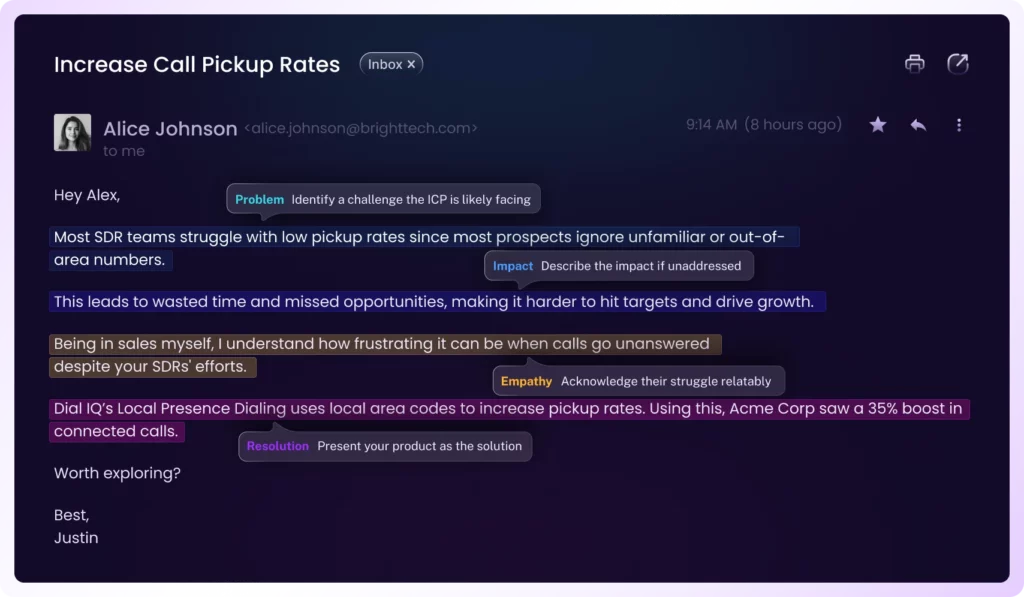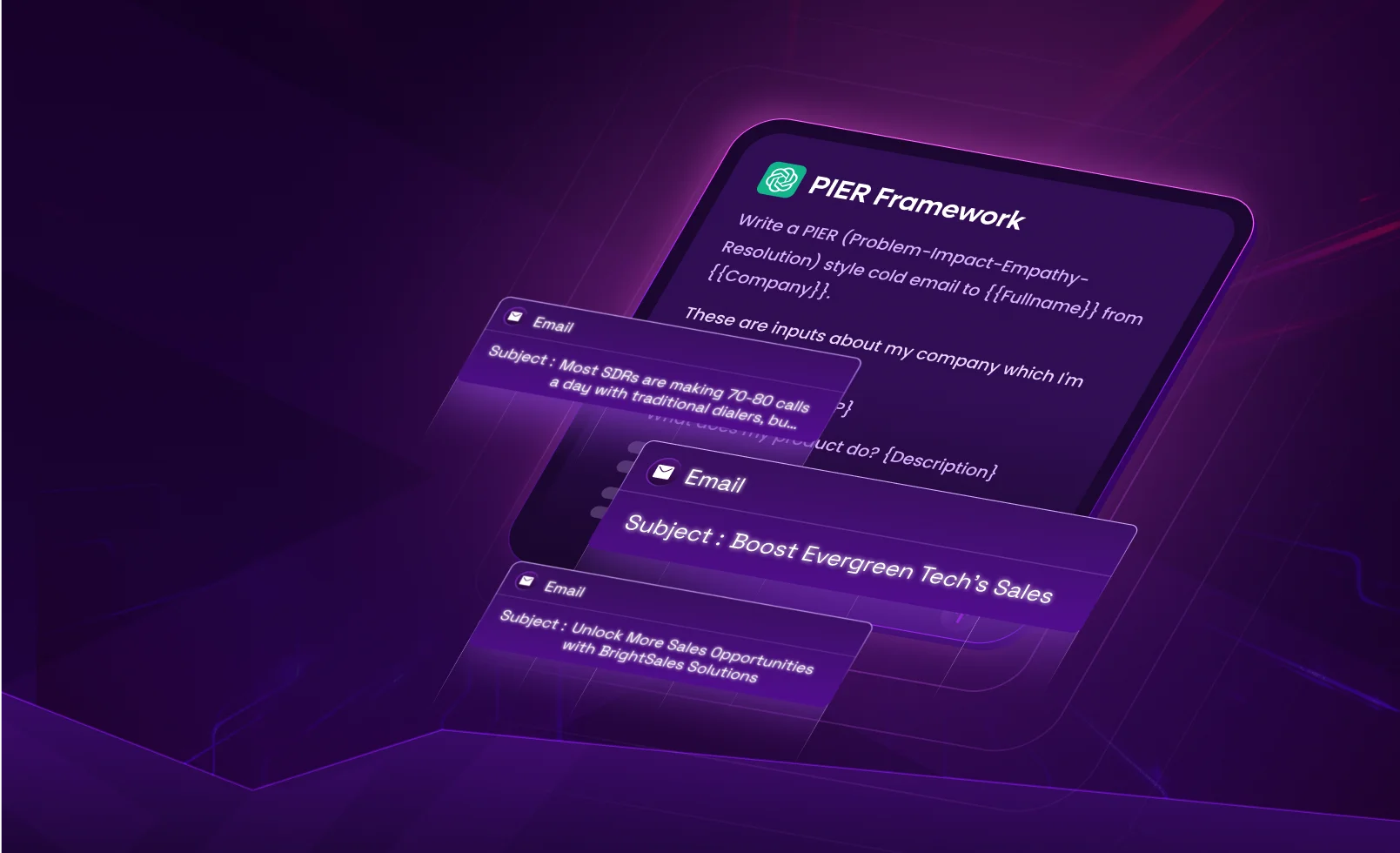Here's the truth about cold emails: If they're just generic templates filled with corporate jargon, they're destined for the trash folder before they're even fully read.
So, how do you craft a cold email that genuinely resonates with your prospect? One that identifies their challenges, demonstrates understanding, and presents your solution as the perfect fit?
Use copywriting frameworks. They've been helping salespeople convert prospects into customers for decades.
The PIER—Problem-Impact-Empathy-Resolution framework is particularly effective. Think of PIER as a journey where you identify your prospect's challenge, highlight the consequences of inaction, show genuine understanding, and then present your solution.
But here's the catch: Not everyone can write persuasive, empathetic emails naturally.
Most sales professionals don't have time to craft perfectly structured messages for every prospect. Writing compelling emails requires understanding the prospect, their pain points, and expressing solutions clearly and concisely.
This is where AI steps in.
Tools like ChatGPT can help sales teams create personalized, effective outreach without spending hours crafting each message.
In this blog, we'll explore the PIER framework developed by Daniel Fazio, provide a ready-to-use ChatGPT prompt, and share an example email generated using this powerful approach.
What Makes PIER Work?
The brilliance of PIER lies in its human-centered approach. Rather than focusing solely on your product's features, it begins with the prospect's challenges and builds a connection through understanding.
PIER creates a narrative that addresses both logical concerns and emotional needs. By highlighting both the problem and its impact, then demonstrating empathy before offering a solution, you create a complete picture that motivates action.
1. Problem: Identify Their Challenge
The first component focuses on pinpointing the specific challenge your prospect faces. This isn't about vague statements - it's about demonstrating insight into their particular situation. The key is showing prospects you've done your research and understand their unique needs.
2. Impact: Amplify the Consequences
The impact phase illuminates what happens if the problem goes unsolved. Here, you help prospects understand the ripple effects of their challenge - how it affects revenue, team efficiency, competitive position, or growth potential. The goal is to bring clarity to what's truly at stake.
3. Empathy: Build Genuine Connection
This is where PIER differs significantly from other frameworks. By explicitly acknowledging the emotional and practical difficulties your prospect faces, you build rapport and trust. Showing empathy demonstrates that you see them as people, not just potential customers.
4. Resolution: Present the Clear Solution
Having established understanding of both the problem and its impact, your solution becomes the natural next step. This section focuses on specific outcomes and demonstrates clear value. The key is connecting your solution directly to their challenge in a way that feels personalized.
💡 ChatGPT Prompt: PIER FRAMEWORK
Write a PIER (Problem-Impact-Empathy-Resolution) style cold email to {{Fullname}} from {{Company}}.
These are inputs about my company which I'm trying to sell:
Ideal Customer: {ICP}
What does my product do? {Description}
The value we provide for the user: {Value Proposition}
What pain points do we solve? {Painpoints}
Competitor Advantage: {Competitor Advantage}
How we have helped people: {Case Study}
This is the input about the prospect: {Prospect_Research}
Write the subject in the following format:
Keep it simple, stating the main topic of the email. Avoid being overly creative or fancy. Limit it to 3-4 words max.
Write the email in the following format:
Problem: Start by identifying a specific challenge or pain point that the prospect, {{Company}}, might be facing based on {Prospect_Research}. Tie this to broader industry trends or needs specific to their target market or ICP. Like "Most ICPs..."
Impact: Explain the potential consequences of not addressing this problem. How does it affect their business, growth, or competitiveness? This helps highlight the importance of finding a solution.
Empathy: Acknowledge the difficulty of addressing this issue, showing that we understand the challenges they face. Be relatable.
Resolution: Introduce our product, {Description}, as a solution to the problem. Provide a specific example from {Case Study} that demonstrates how our solution has helped similar companies.
End with a CTA - either "Worth a chat?" or "Worth exploring?".
Guidelines:
Keep the email under 80 words.
Use a friendly, direct tone.
Make sure to bring forth all the mentioned elements of formatting.
Avoid vague terms like "streamline," "optimize," "maximize," etc.
Be as specific as possible without making assumptions about the prospect.
Sample Output:

Conclusion
The PIER framework and prompt provided are your blueprints for writing high-converting cold emails that establish genuine connection.
But the real challenge is scaling this empathy-driven approach for hundreds of prospects. Even with AI, executing this effectively at scale is a struggle.
That's why we built SDRx—an AI outbound agent that handles everything from in-depth prospect research to perfectly timed follow-ups, creating qualified pipeline without the manual grind.
By analyzing prospect behavior and leveraging 25 copywriting frameworks, SDRx generates highly personalized emails at scale, ensuring every outreach is relevant and impactful.
Want to use AI to create personalized, human-like emails for every prospect?
Book a demo of SDRx today.


